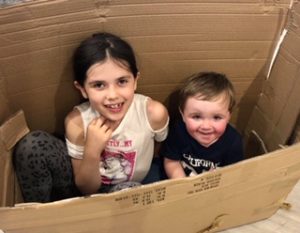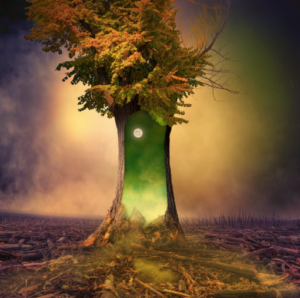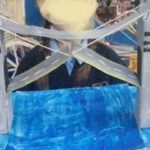Hello everyone! We hope you’re well and staying positive. We’re missing you lots but have really enjoyed hearing all about the wonderful things you’ve been getting up to with your families. This week, we’ve been doing lovely things with our families too…
Mrs Atkins has been spending yet more time in her garden. It’s a really interesting time outside in nature at the moment. She has spotted that the flowers on the fruit trees and bushes are falling off and in their place, fruits are forming. Look! Can you see? Can you identify these fruits from Mrs Atkins’s garden in the pictures below: blueberries, raspberries, apples and plums?
You might remember that Mrs Pike has been building her own home on the farm. She’s very excited to be moving in next week so this week has included a lot of painting and moving furniture! She has also squeezed in some baking and has made an apple Dorset cake.
Miss Shaw has enjoyed spending time with her baby, Odi. Look how cute he is! Who knew there were so many unexplored walks around our area! There’s even a waterfall!
Here is the home learning for this week…
Topic:
How would different weather affect each stage of farming? Consider the effect on different crops such as fruits, wheat, corn, grass (for animal feed), potatoes etc.
| Ploughing | Sowing | Crop Spraying | Harvesting | |
| Drought (No rain) | Land would be hard and difficult to plough. | |||
| Average Rain | ||||
| Heavy Rain/ Flooding | ||||
| High winds | Fruit could be blown off before collecting and become spoiled. | |||
| No wind |
CHALLENGE – What would ‘ideal’ weather look like for a wheat farmer vs a grass-fed cow farmer?
SUPPORT – Plant and grow any type of seed you can find in three pots of soil. In Pot 1, give it no water to simulate drought. In Pot 2, give it a constant supply of water to simulate heavy rain or a flood. In Pot 3, try to make sure there are optimum conditions (perfect for growing). Look closely to see what happens to the plants and the soil.
English: The magic tree.
Sentence challenge!
A preposition is a word that shows the relationship between one thing and another. It usually tell you where a thing is in relation to something else (the position) E.g. The green, shining door appeared inside the tree. Can you write a minimum of 3 sentences about this magic three that contain prepositions?
If this was a portal to another world, would you go through it or stay on Earth? If you walked through the portal, what would happen to you? What would you see?
Imagine you have just walked through the open portal and into the world inside the tree. Draw and then describe what you can see – remember to use fantastic adjectives to create expanded noun phrases.
Guided reading:
Hidden nature. Use the image to answer the questions, remember this is using your inference skills so there’s exact answer, it’s reading between the lines and using the clues to help.
- Where did the robot get the egg from?
- Why is the robot watering the egg?
- How are things growing in this room?
- Why is he keeping it hidden?
- Does anyone else know it’s there?
- What do you think the world outside this room is like?
- Do you think the egg will hatch? What will be inside?
Science / Geography: Where does your food come from?
Think about / research what crops we grow in our country? Compare it to crops grown in other countries. Can you find out where certain foods come from? Use a map / globe to locate these places and label/ draw pictures of the food type in the correct place on a blank world map.
Challenge:
What do other countries grow that we don’t? Why can’t we grow certain foods in our country but they can in others? Present your findings in any way you wish (table, poster, information leaflet etc.)
Key vocabulary: Climate, biodiversity,
Use this website to support your learning:
https://www.cbd.int/ibd/2008/youth/farmers/
Maths
We have heard from other year groups that children are really enjoying these maths lesson from the national academy. They included a quiz, a teacher video, an activity to complete and an end quiz to check your learning. Here are the first two angle lessons. Give them a go and let us know what you think. Other children have enjoyed having a mini lesson from a teacher.
https://www.thenational.academy/year-3/maths/to-identify-and-recognise-angles-year-3-wk4-1
https://www.thenational.academy/year-3/maths/to-identify-angles-inside-2-d-shapes-year-3-wk4-2
Music from Mrs Sumba
Ravi Shankar
Go to the website below and watch Naomi Wilkinson’s video about Ravi Shankar.
https://www.bbc.co.uk/teach/ten-pieces/classical-music-ravi-shankar-symphony-finale/znk8bdm
Why is Shankar considered to be a musical trailblazer?
Now listen to the whole piece in the second video. Make a list of the different instruments you can see. Choose 1 and find out 3 facts about it.
Spelling
Pick words from the Year 3/4 Spelling List and practice them by writing them out in your neatest handwriting.
Art from Mrs Pearson :
Art Challenge Famous Landmarks:
For this week’s Art Challenge I would like you produce some art that is linked to a famous landmark. Your landmark can be natural or man-made. It can be a drawing, a sculpture made from recycled materials, a collage, something made out of pebbles and twigs , it could be drawn on a tablet or made out of Lego, or indeed else that you can think of. I have even seen Big Ben made out of socks! Let you imaginations run wild!
Here are a few ideas:
Science from Miss Stapley
Balancing Structures
The activity – Make a balancing toy.
Experiment with the design of your toy to find out what affects whether or not it balances.
Learn about the centre of mass of an object and how it relates to whether or not something balances. https://www.rigb.org/docs/balancing_sculptures_infosheet_0_0.pdf – activity worksheet in full
What you need:
- A carrot or similar vegetable
- Kebab skewers
- Marshmallows and/or other jelly type sweets, or small pieces of carrot or similar hard vegetables.
- Plasticine or blu-tac
- 500ml soft drink bottle or washing up liquid bottle
Stage 1: Cut a piece of carrot about 3 cm long. Stick a kebab skewer into one end of the piece of carrot and break the skewer so that you have only 2 or 3 cm of it sticking out. Try to stand the carrot piece up on the end of the kebab skewer – you should find this very difficult, if not impossible to do.
Stage 2: Stick a kebab skewer into each side of the carrot so that they point downwards at about 45 degrees. Then stick a marshmallow or other jelly sweet onto the ends of the skewers, as shown in the picture below. Place this on top of a bottle and you should find that it balances.
Get children to investigate what happens when you slide the marshmallows up and down the ‘arms’ of the sculpture and if you add more marshmallows. Stick an additional two or more kebab skewers into the carrot and challenge children to add at least one item to each skewer and still keep the sculpture balanced.
Questions to ask children: With just central part of the sculpture: why doesn’t this stay balanced? Before showing them stage 2: do you think we can use more kebab skewers and anything else to help it balance? Why do you think it balances like this? What can we change? (position of skewers, items pushed onto the skewers, position of things on skewers) What do you think will happen if we change these things? What do you think we need to do to make sure our sculpture balances?
Going further:
Try making some animal-shaped balancing toys: http://bit.ly/AniBalance
Make a balancing butterfly: http://bit.ly/BalanceButterfly
Have a wonderful and safe weekend!
Miss Shaw, Mrs Atkins and Mrs Pike













